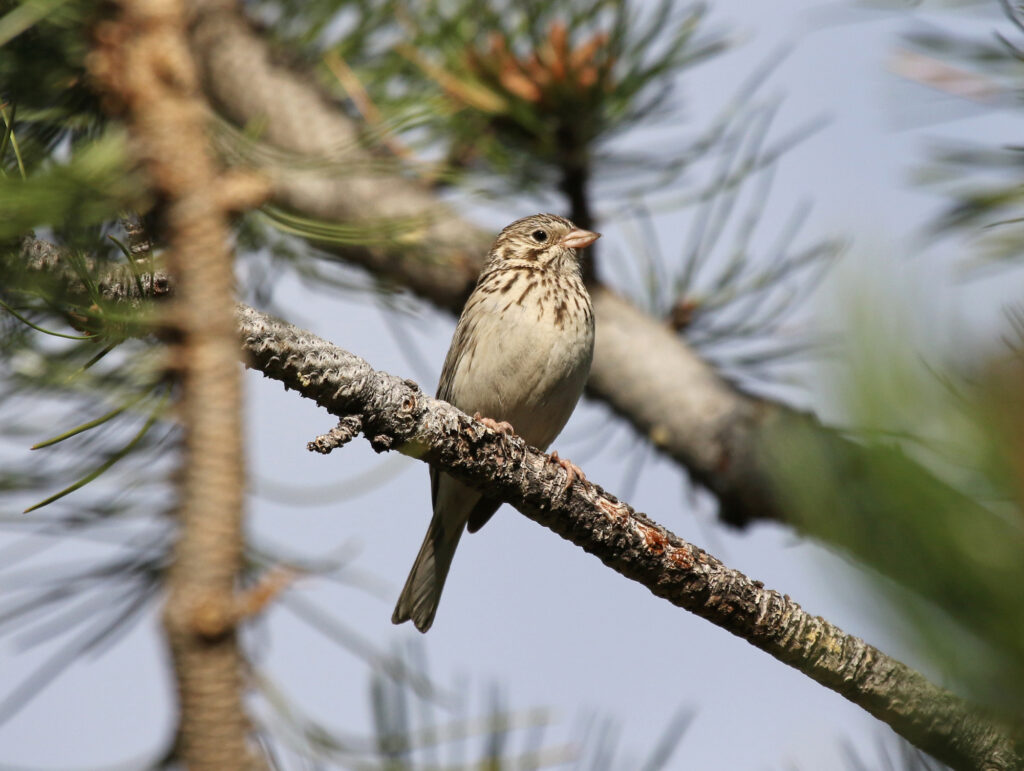North Dakota is a part of the Great Plains and is a state with immense agricultural and mineral resources. But the rapid conversion of prairie land to arable farms has had a big impact on wildlife populations.
We’ve counted 24 sparrow species that can be seen in the Peace Garden State, but some of the grassland specialists are very rare and declining.
The state’s northerly position on the border with Canada means cold winter months, so for most sparrows, North Dakota is purely a summer breeding ground. A few sparrows, however, remain here year-round, and amazingly, two species even use the state solely as winter territory!
While sparrows are often thrown into the ‘LBJ’ category and can be hard to tell apart, it can be greatly rewarding to learn the nuanced differences in their plumage and songs to identify each species. We’re here to help you do that, as well as to share some fascinating facts about these endearing little birds.
Sparrows in North Dakota, Starting with the Most Common
House Sparrow

- Species Name: Passer domesticus
- Length: 5.9-6.7 in (15-17 cm)
- Weight: 0.9-1.1 oz (27-30 g)
- Wingspan: 7.5-9.8 in (19-25 cm)
The prize for the most frequently spotted sparrow in North Dakota goes to… the house sparrow! Not that they are necessarily the most numerous sparrow in the state, but the fact that they like to live in man-made buildings means they’re seen often!
House sparrows are the only sparrow species which is found in all 50 states, and they aren’t even native! They were introduced to the United States in 1852 from Europe and their presence has been met with a mixed reception.
Because house sparrows don’t migrate, they can often dominate the nesting grounds of native birds. Nevertheless, they’re cute little critters, and some people have even trained them to eat from their hands!
Song Sparrow

- Species Name: Melospiza melodia
- Length: 4.7-6.7 in (12-17 cm)
- Weight: 0.4-1.9 oz (12-53 g)
- Wingspan: 7.1-9.4 in (18-24 cm)
Song sparrows are the most commonly spotted sparrow across the United States, and the second most seen in North Dakota. Like most sparrows, however, you’ll only find them here in the summer.
It’s during the breeding season that the song sparrows are one of the most vocal of all sparrows, so learning their song is an excellent way to distinguish them from other brown-streaked sparrows.
Interestingly, scientists have discovered that song sparrows adapt their song according to their environment – their country song is different from the one they sing in the city!
Chipping Sparrow
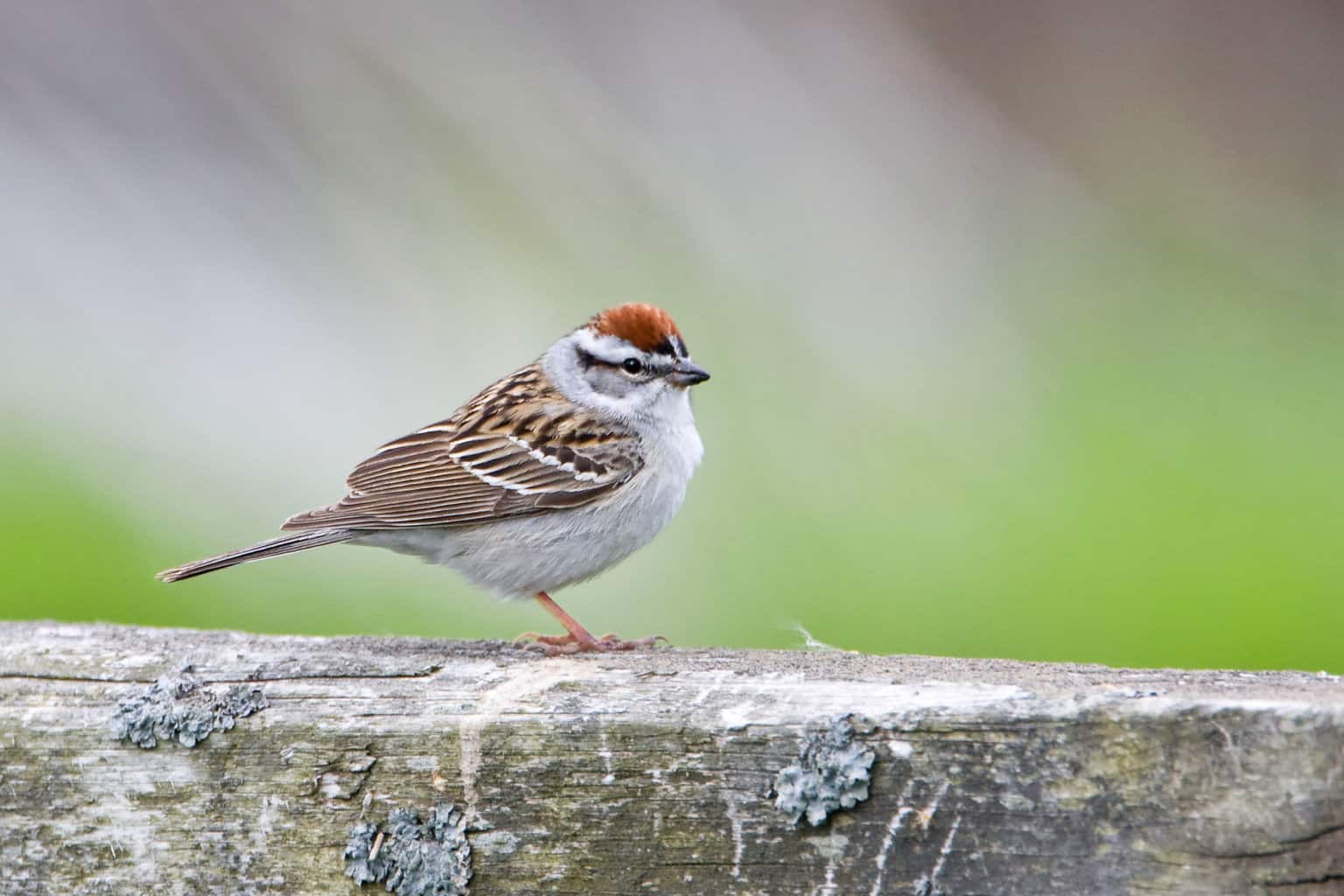
- Scientific Name: Spizella passerina
- Length: 4.7-5.9 in (12-15 cm)
- Weight: 0.4-0.6 oz (11-16 g)
- Wingspan: 8.3 in (21 cm)
Chipping sparrows are tiny birds that have one of the largest ranges of any sparrow species. North Dakota is merely a summer ground for these common birds when they can be found nesting in open woodlands and leafy suburbs.
Chipping sparrows can be recognized by their small size, rusty crown feathers, black eye lines, and gray chests. They’re also very vocal, with a fast, high-pitched trill as their simple song.
Dark-eyed Junco
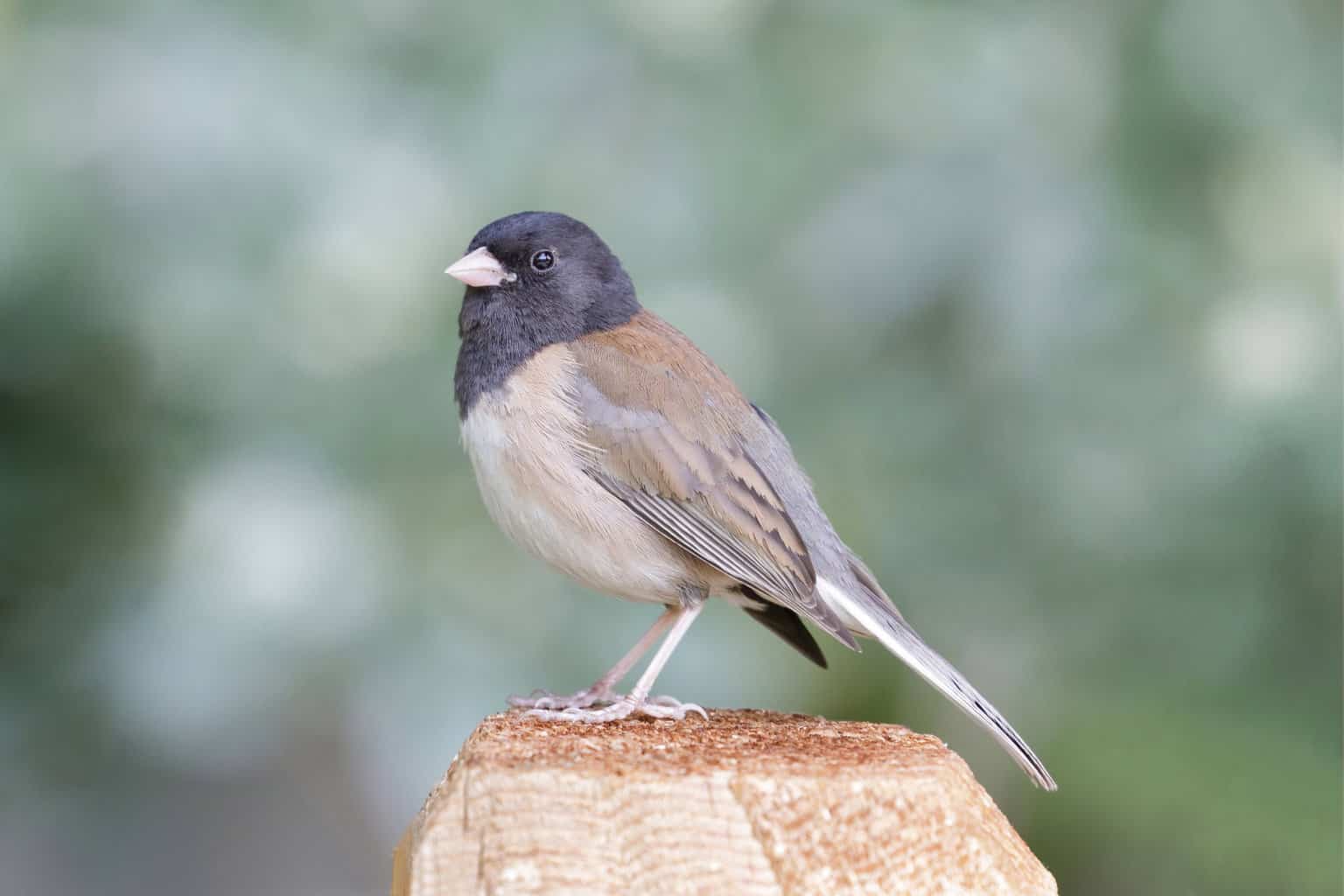
- Scientific Name: Junco hyemalis
- Length: 5.5-6.3 in (14-16 cm)
- Weight: 0.6-1.1 oz (18-30 g)
- Wingspan: 7.1-9.8 in (18-25 cm)
Dark-eyed Juncos are sometimes known as ‘snow birds’ because they appear to be so hardy. Believe it or not, they are primarily winter residents here, with the vast majority of them breeding further north.
But the story is more complicated than that. While the most common juncos in North Dakota are the slate-colored, other subspecies such as the pink-sided, Oregon, white-winged, and gray-headed dark-eyed juncos can occasionally be found here, too.
These variants may occasionally breed (and even interbreed) in the state, making this one of the most complex bird species on our list (phew!).
Dark-eyed juncos are enthusiastic visitors to backyard feeders where they’ll happily chow down on sunflower seeds and peanuts.
Clay-colored Sparrow
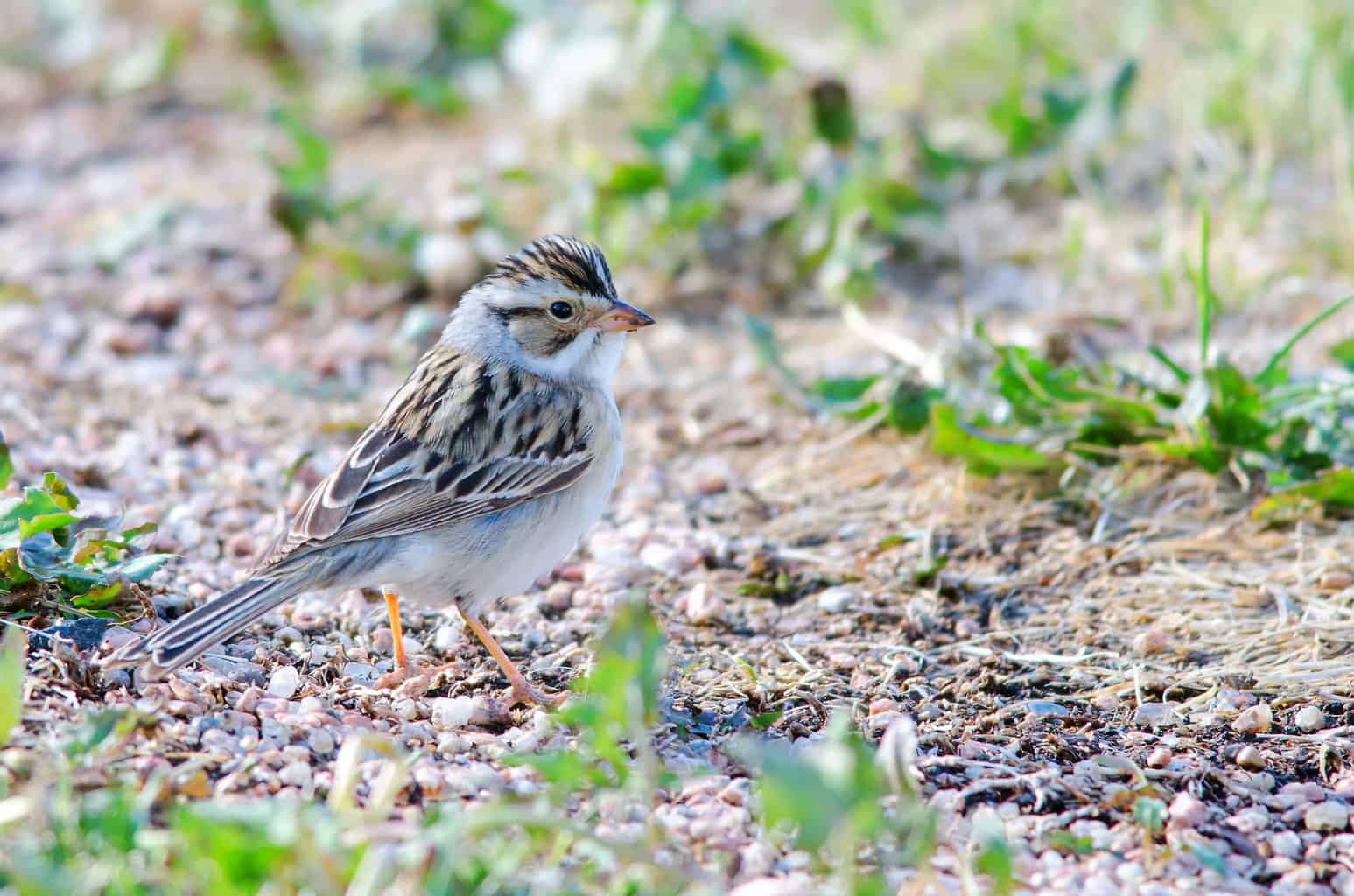
- Scientific Name: Spizella pallida
- Length: 5.1 – 6 in (13 – 15 cm)
- Weight: 0.42 oz (12 g)
- Wingspan: 7.5 in (19 cm)
Clay-colored sparrows are a cousin of the chipping sparrow with an impressive migratory range. Unlike their cousins, they are merely a migrant in most of the United States and only breed in the country’s northernmost territories.
But during the breeding season, the clay-colored sparrow isn’t really so clay-colored at all. Shedding their pinkish brown winter plumage, much of their body turns a pale-gray to white color between April and August.
It’s at this time of the year that you’ll find plenty of these beautiful birds throughout North Dakota, nesting among dense vegetation in open areas with scattered bushes. The young leave the nest after a week, but are bound to run along the ground until they learn to fly!
Savannah Sparrow
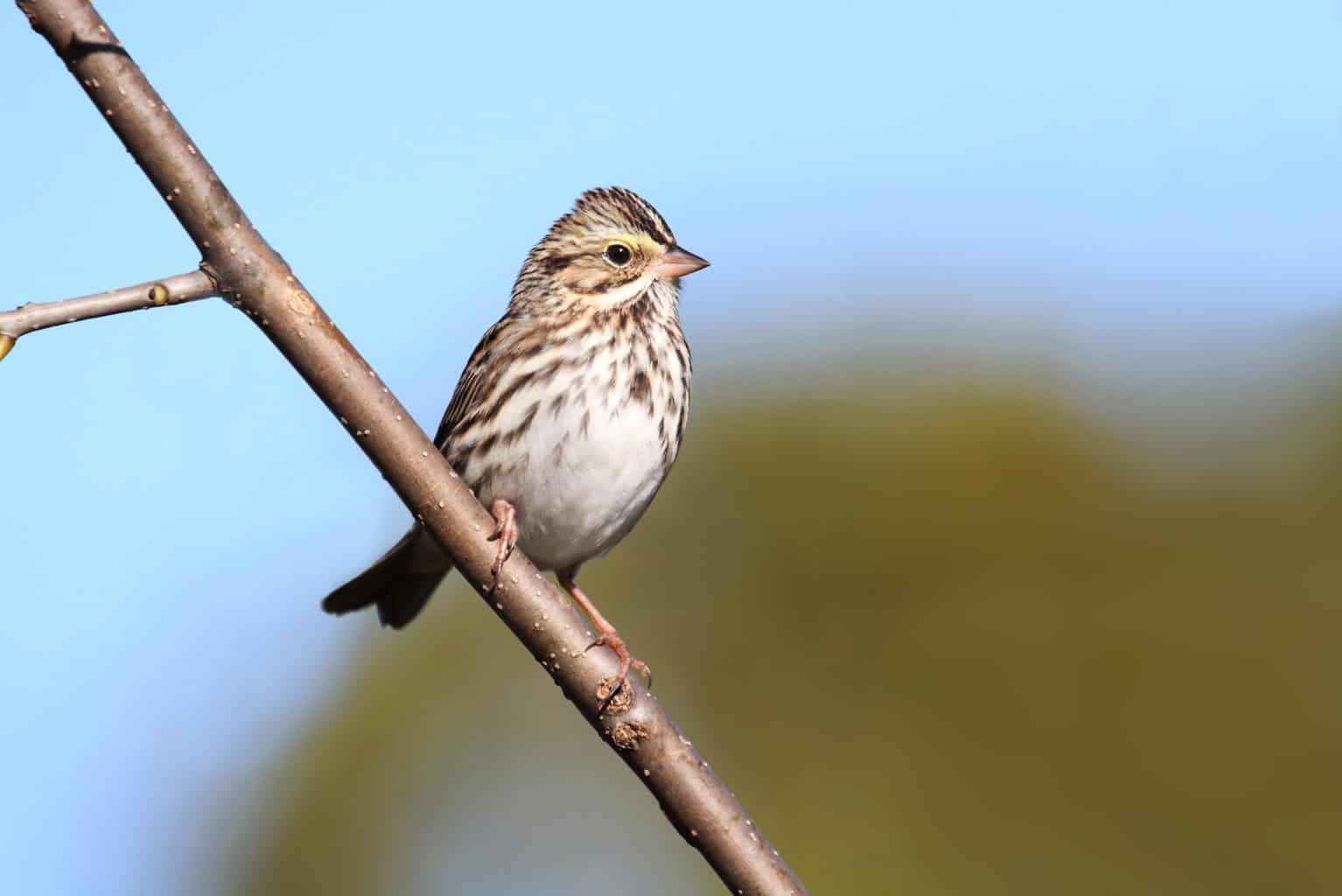
- Species Name: Passerculus sandwichensis
- Length: 4.3-5.9 in (11-15 cm)
- Weight: 0.5-1.0 oz (15-28 g)
- Wingspan: 7.9-8.7 in (20-22 cm)
Savannah sparrows are another genetically diverse sparrow, and the various subspecies have slightly different plumage variations. In general, though, these medium-sized sparrows have white chests with brown streaks, and yellowish tinting around their eyes.
Savannah sparrows are purely summer visitors in North Dakota when large numbers of them come to build their nests on the ground in the state’s prairies and grasslands.
Often seen in open fields, Savannah sparrows will often fly to perch atop tall weeds stalks, and fences when disturbed.
White-throated Sparrow
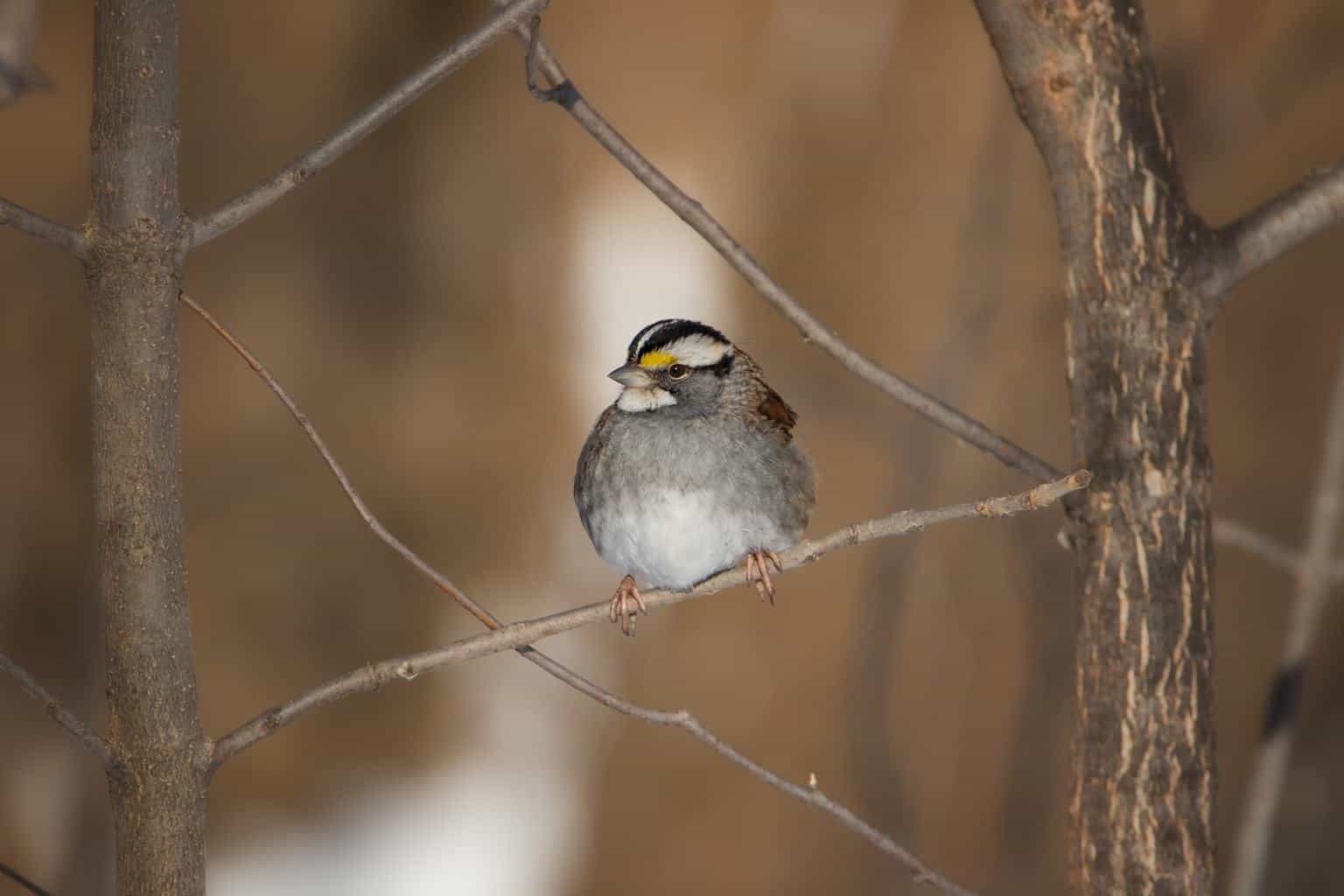
- Scientific Name: Zonotrichia albicollis
- Length: 6.3-7.1 in (16-18 cm)
- Weight: 0.8-1.1 oz (22-32 g)
- Wingspan: 7.9-9.1 in (20-23 cm)
Except for a very small breeding population on the border with Sasaskatuwan, white-throated sparrows are merely a migratory species in North Dakota. It’s surprising then, that they’re such a frequently spotted species here!
The huge flocks of these largish sparrows that pass through the state in the spring and fall don’t go unnoticed by North Dakota residents. These largish sparrows may also stop off to visit backyard bird feeders, especially in the autumn.
The yellow ‘eyebrows’ and black and white, (or black and tan) stripes on their crowns, make these easy-to-recognize sparrows. Their famous melancholic song can also be remembered by the mnemonic ‘Oh sweet Can-a-da, Canada, Canada!
Vesper Sparrow
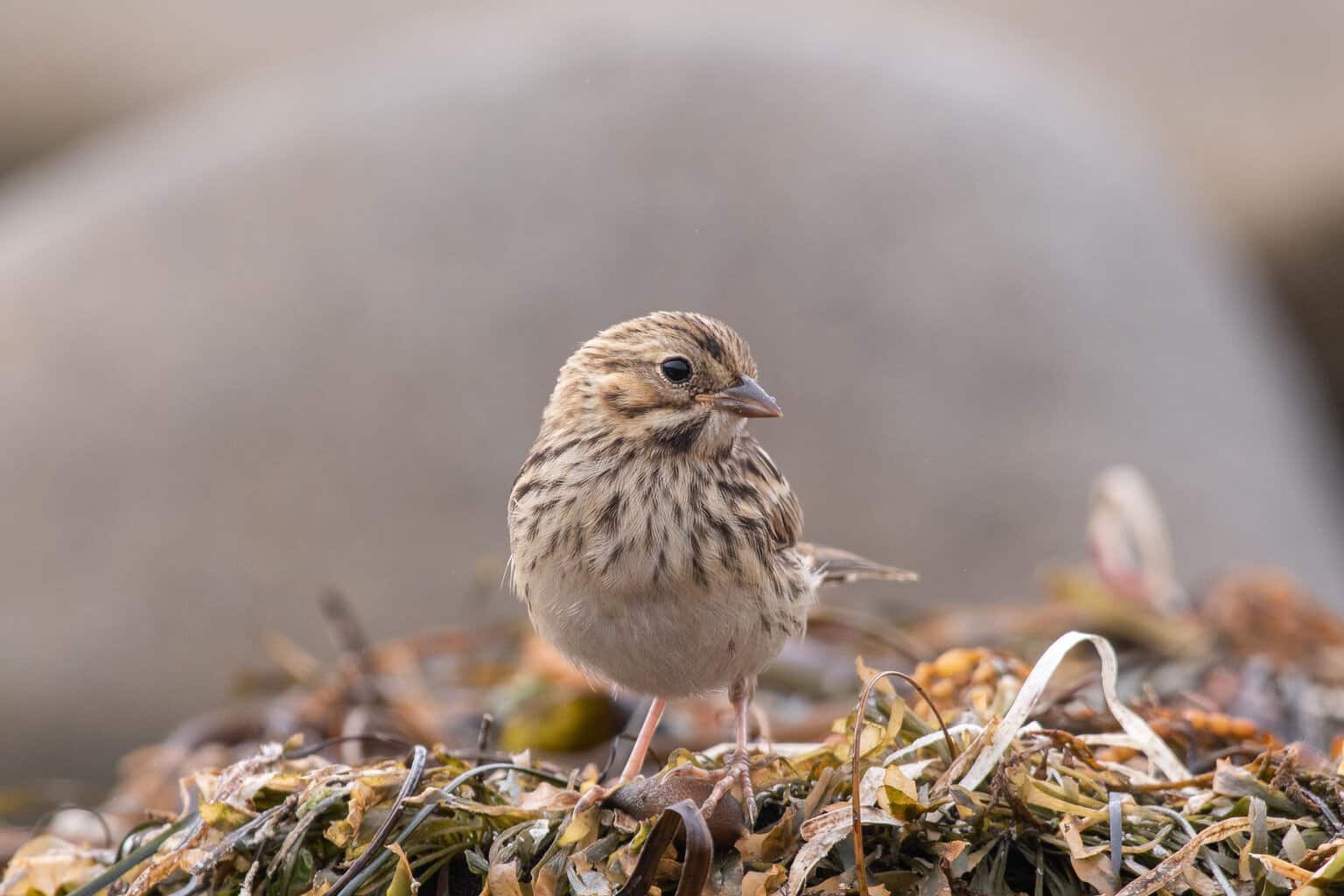
- Scientific Name: Pooecetes gramineus
- Length: 5.1-6.3 in (13-16 cm)
- Weight: 0.7-1.0 oz (20-28 g)
- Wingspan: 9.4 in (24 cm)
Along with its cream belly and stout bill, the best way to identify vesper sparrows is its fast-trilling call that carries through the grassy plains and meadows that they inhabit.
Just a summertime bird in North Dakota, vesper sparrows look and behave much like Savannah sparrows but are rather larger.
The sparrow species is omnivorous, feeding mainly on insects, spiders, weeds, and grass seeds, and relying on native grasslands for their survival.
Grasshopper Sparrow
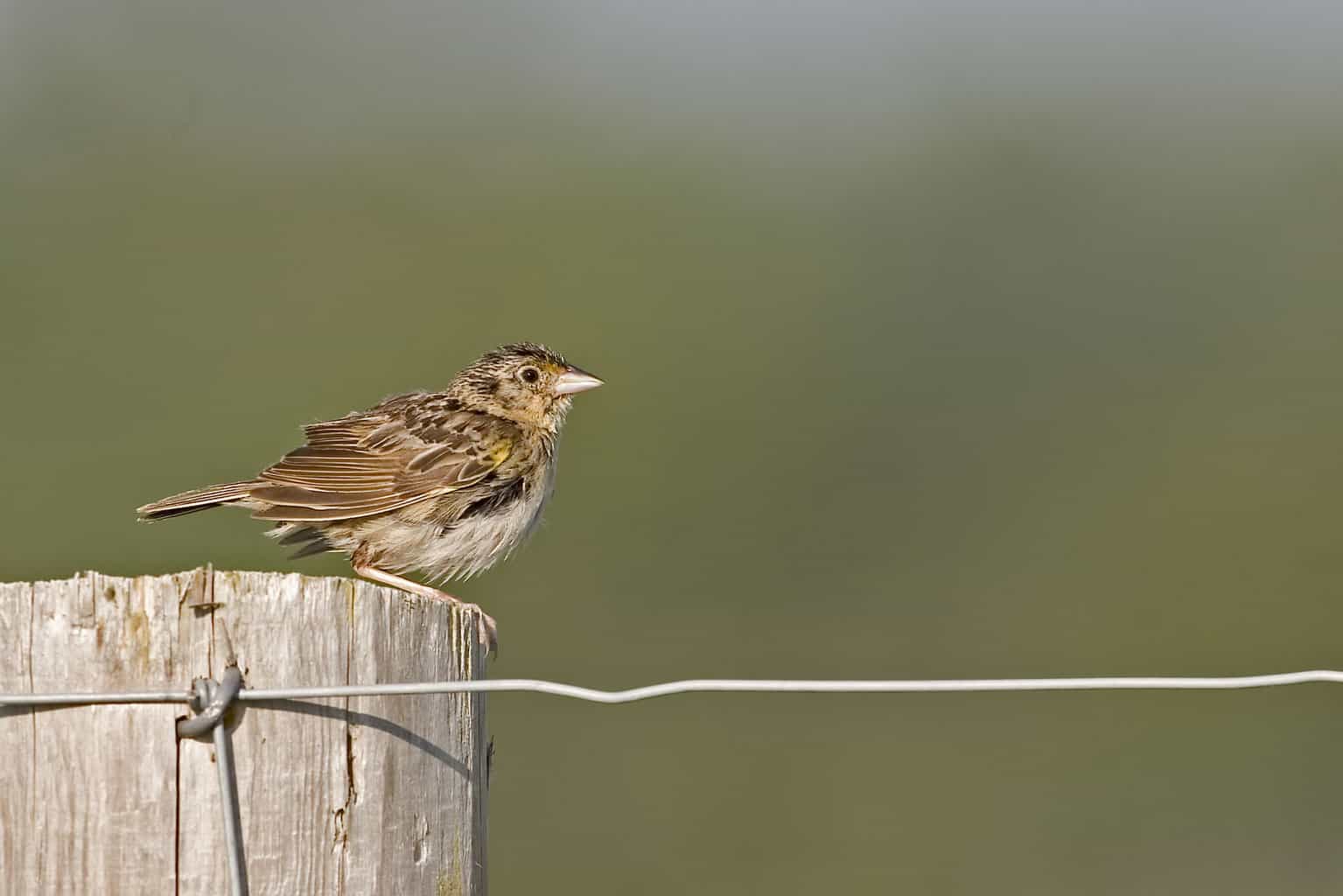
- Species Name: Ammodramus savannarum
- Length: 4.3-4.5 in (10.8-11.5 cm)
- Weight: 0.5-0.7 oz (14-20 g)
- Wingspan: 7.9 in (20 cm)
Grasshopper sparrows are tiny birds of dry grassland habitats. Not only does their song sound like a grasshopper’s, but they also love eating them and feeding them to their young!
These large-headed, large-billed birds are purely summer visitors in North Dakota and build their nests on the ground from grasses and other plant material. These beautiful little structures often have a roof created by weaving surrounding vegetation together!
Grasshopper sparrow numbers have declined by a massive 70% over the past 50 years, which just goes to show how extensive the damage to native grasslands has been.
Lark Sparrow
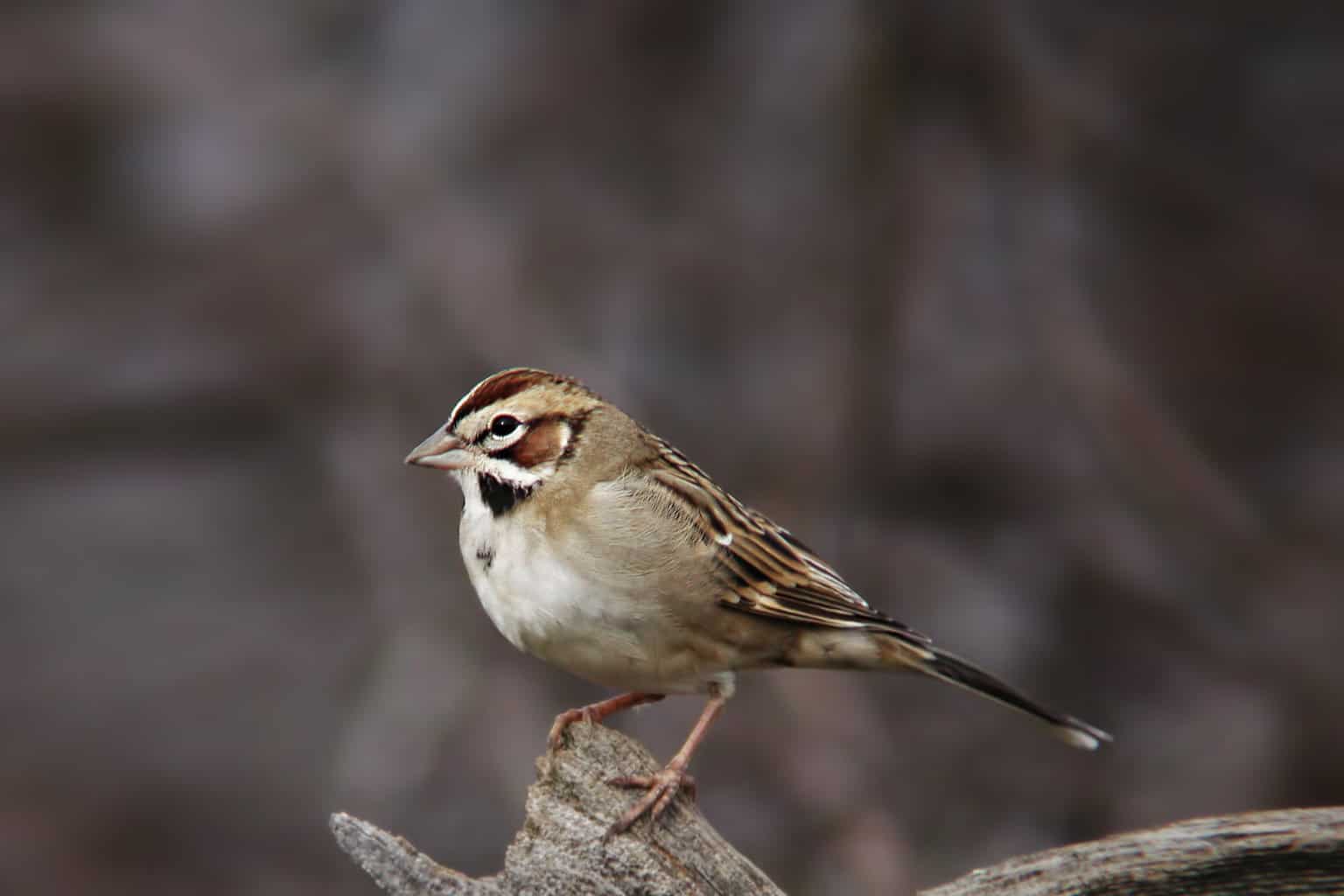
- Scientific Name: Chondestes grammacus
- Length: 5.9-6.7 in (15-17 cm)
- Weight: 0.8-1.2 oz (24-33 g)
- Wingspan: 11.0 in (28 cm)
Lark sparrows are very large grassland sparrows with brown and white striped heads, white bellies, and white-edged tails.
North Dakota is near the northern edge of this bird’s breeding range, but that doesn’t stop them from being seen frequently here during the spring and summer months.
You tend to find these large sparrows in open grassland interspersed with trees and shrubs.
Harris’s Sparrow
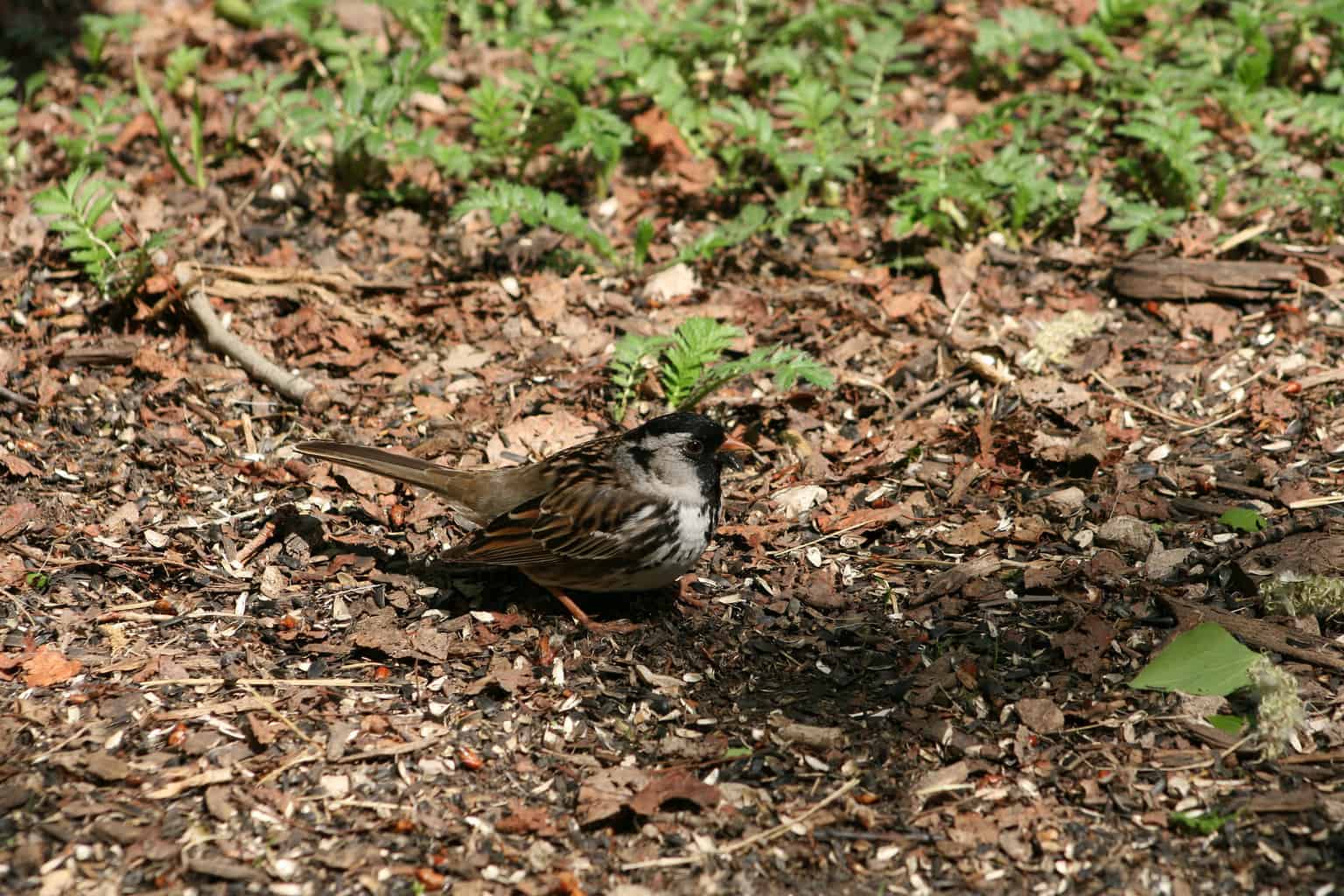
- Species Name: Zonotrichia querula
- Length: 6.7-7.9 in (17-20 cm)
- Weight: 0.9-1.7 oz (26-49 g)
- Wingspan: 10.6 in (27 cm)
Except for the even larger towhees, Harris’s sparrow is the largest of all sparrows in North America. Their most unmistakable feature is their black face and throat, which becomes even more pronounced in the breeding season.
North Dakota lies right at the heart of Harris’s sparrow’s migratory route, which extends from Texas to Northern Central Canada. So even though they’re only a passing migrant here, large numbers of them are seen passing through every spring and fall.
Harris sparrow often mixes with other sparrows in the Zonotrichia tribe, such as white-crowned, and white-throated sparrows.
White-crowned Sparrow
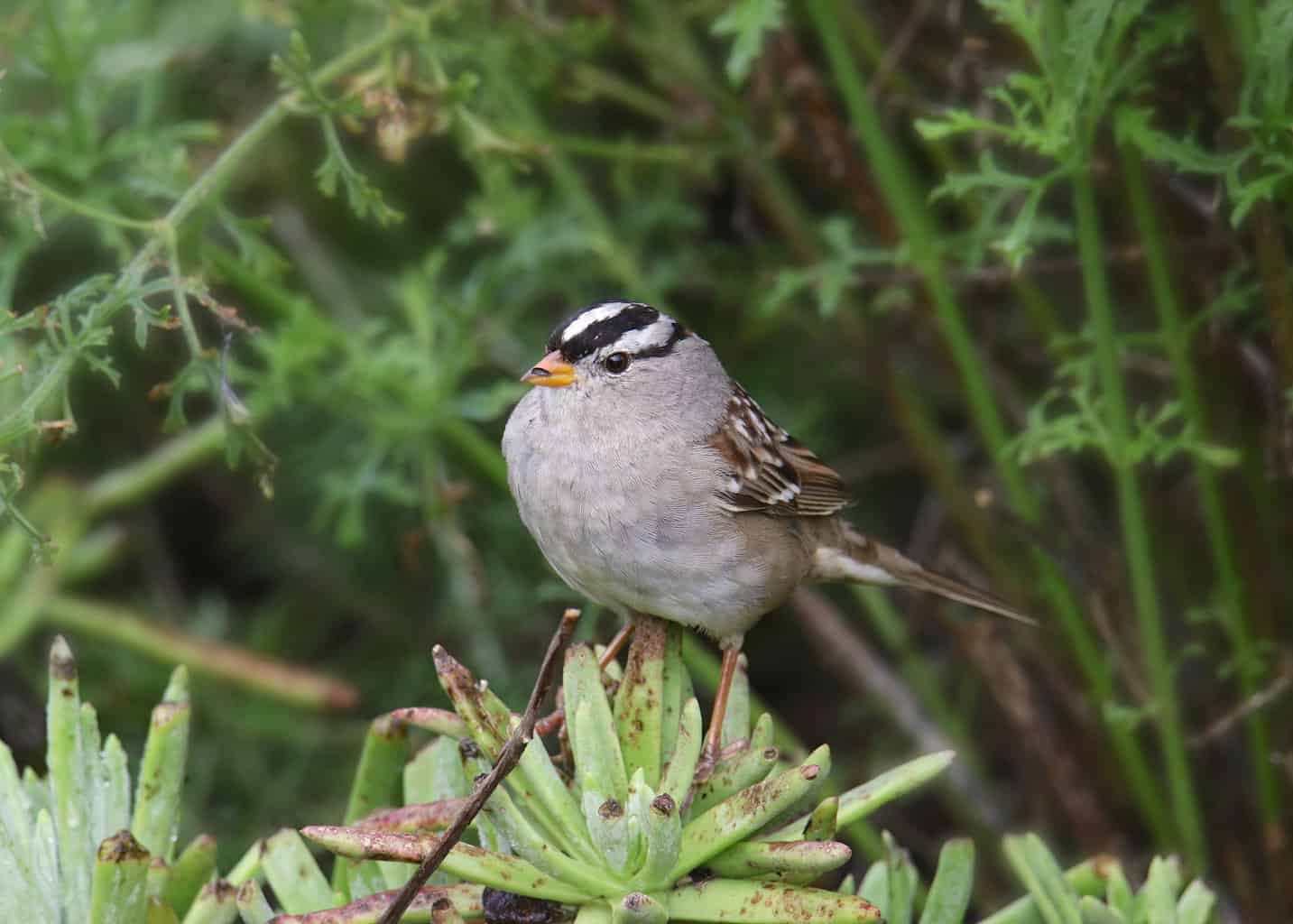
- Scientific Name: Zonotrichia leucophrys
- Length: 5.9-6.3 in (15-16 cm)
- Weight: 0.9-1.0 oz (25-28 g)
- Wingspan: 8.3-9.4 in (21-24 cm)
White-crowned sparrows are close cousins of the Harris’s and White-throated sparrows, with a black and white crown and yellowish beak.
Like their relatives, they are more of a migratory species in North Dakota. It’s during the spring and fall that you’ll see large numbers of them passing from their winter grounds in the southern US to their breeding territories in the rocky mountains and Northern Canada.
You can try to get these birds to stop off in your backyard in the fall by offering treats such as black oil sunflower seeds and millet.
Lincoln’s Sparrow
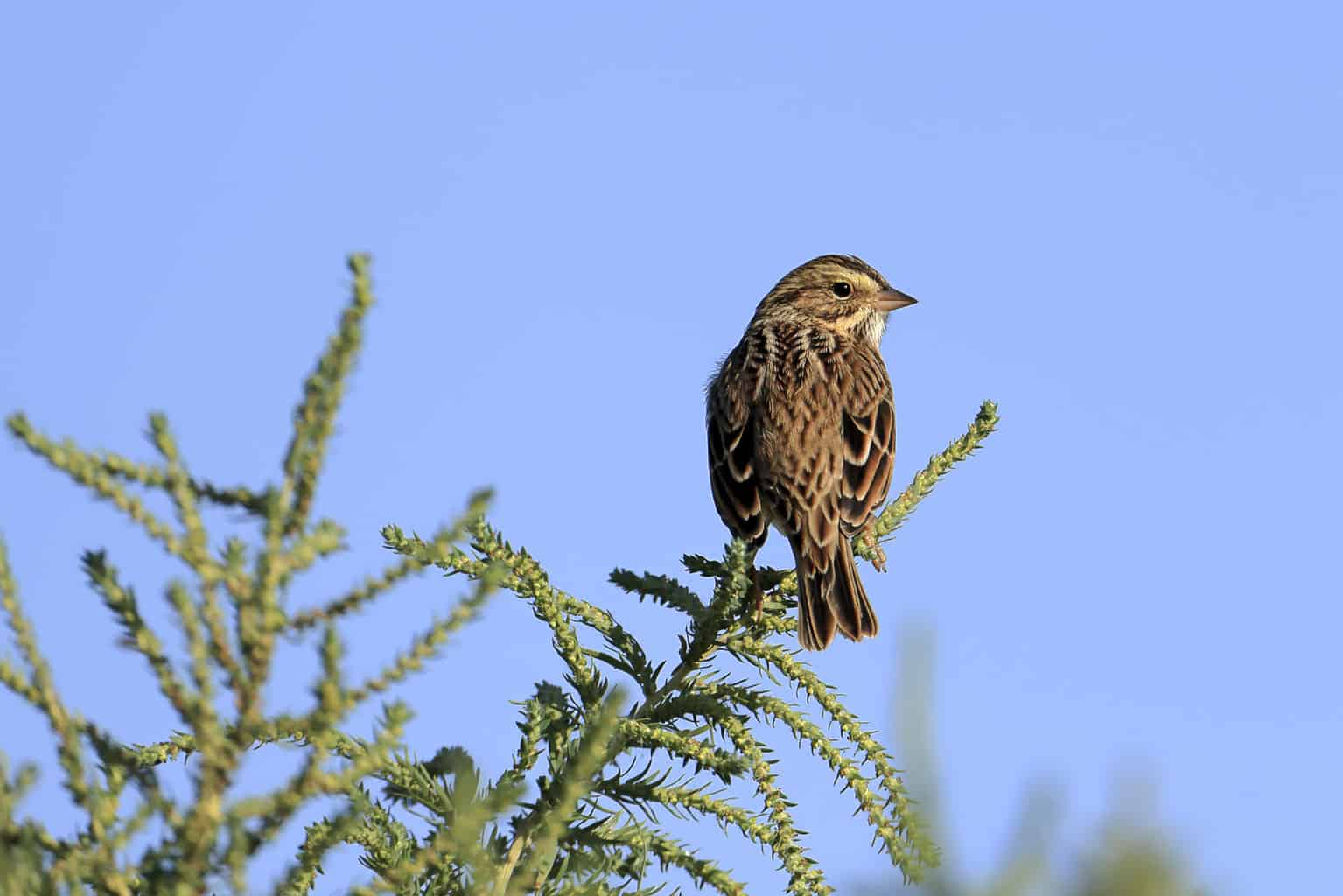
- Scientific Name: Melospiza lincolnii
- Length: 5.1-5.9 in (13-15 cm)
- Weight: 0.6-0.7 oz (17-19 g)
- Wingspan: 7.5-8.7 in (19-22 cm)
Yet another migratory species in North Dakota, but Lincoln’s sparrow’s nesting grounds are not far away, in Saskatchewan and Manitoba.
While the brown-streaked Lincoln’s sparrows might be fairly plain to look at, the same couldn’t be said about their song. Their sweet, gurgling lullaby is something to savor if you’re lucky enough to hear them on their way through in the spring.
Like their cousins, the song sparrow, and swamp sparrow, these birds love water and may be more inclined to visit when offered a garden pond or bird bath.
Field Sparrow
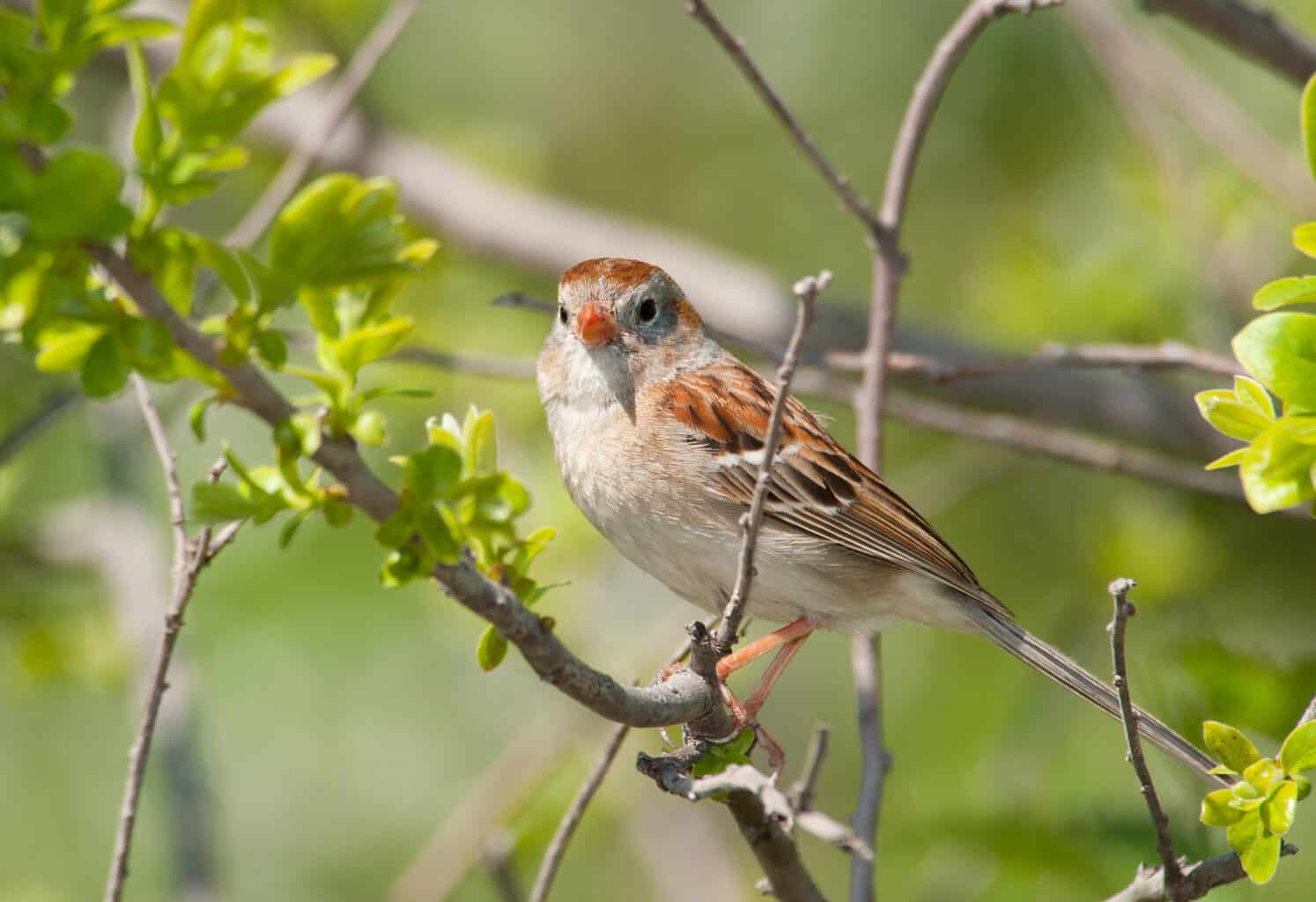
- Scientific Name: Spizella pusilla
- Length: 4.7-5.9 in (12-15 cm)
- Weight: 0.4-0.5 oz (11-15 g)
- Wingspan: 7.9 in (20 cm)
Although field sparrows are fairly difficult to distinguish by sight alone, they can be told apart from other similar-looking species by their loud, high-pitched call that sounds a bit like a bouncing ball coming to a stop!
These small sparrows do nest in North Dakota, but mostly in the east and west of the state. Since North Dakota is at the upper reaches of their breeding range, their distribution is rather localized here.
Field sparrows nest on the ground and, once hatched, their young only take about one week to fledge!
American Tree Sparrow
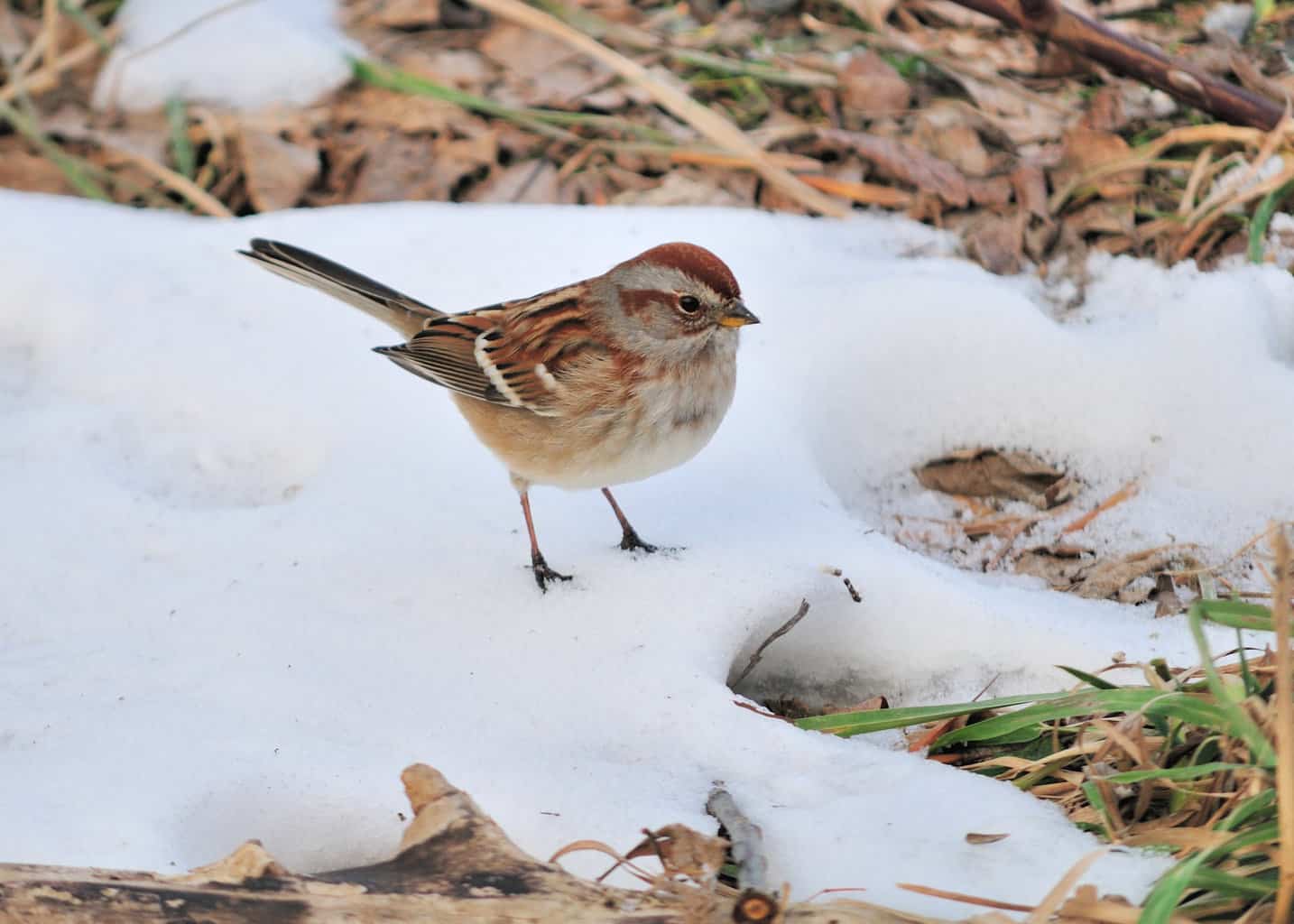
- Scientific Name: Spizelloides arborea
- Length: 5.5 in (14 cm)
- Weight: 0.5-1.0 oz (13-28 g)
- Wingspan: 9.4 in (24 cm)
With their rufous crowns and eyelines, the American tree sparrows look like slightly larger versions of the field sparrow. But they’re also seen on the opposite side of the year to their relatives.
Other than the dark-eyed junco, the American tree sparrow is the only other sparrow that’s found in North Dakota only in winter.
These amazingly hardy little birds have the most northerly distribution of any sparrow and can be found throughout the state in winter, except for the northwesternmost corner.
Did you know that the American tree sparrow’s name is a misnomer? It was so-called by European settlers who thought that it reminded them of their native tree sparrow. In fact, this species spends more of its time on the ground, and nests in the arctic tundra where trees are nowhere to be found!
Lark Bunting
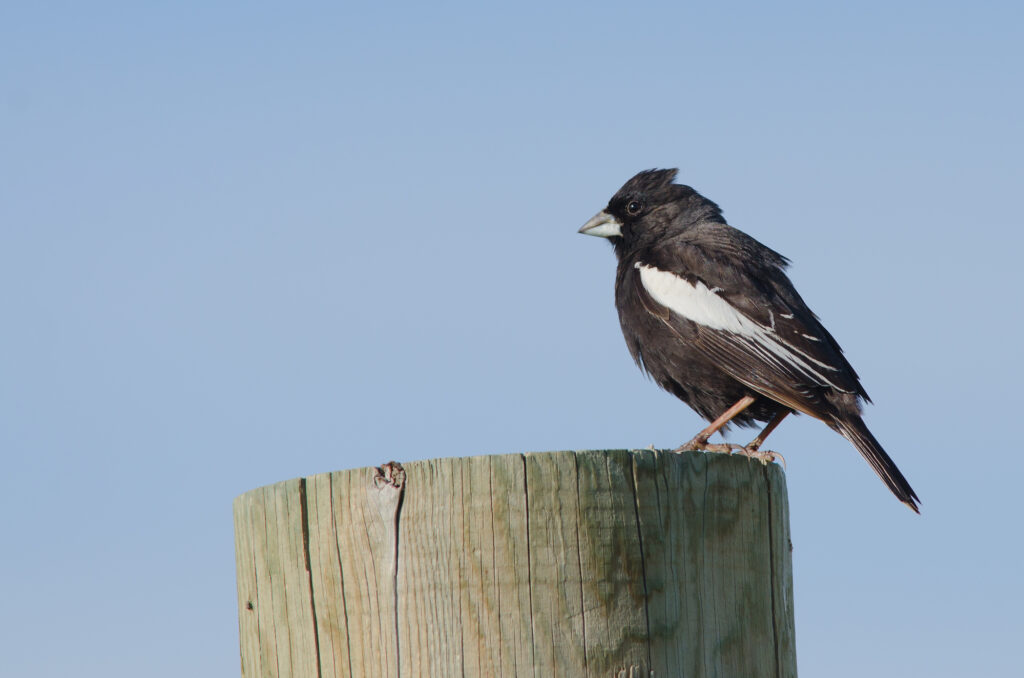
- Scientific Name: Calamospiza melanocorys
- Length: 5.5-7.1 in (14-18 cm)
- Weight: 1.3-1.5 oz (35.3-41.3 g)
- Wingspan: 9.8-11.0 in (25-28 cm)
Now, for a unique sparrow that is bound to turn heads! During the spring and summer, residents of the western parts of North Dakota are treated to the breeding plumage of the male lark bunting – a sleek, jet-black outfit, contrasted by striking white-edged wings and tail feathers.
Preferring dry prairie habitats, their nest is an open cup, usually built on a mound in a grassy area away from trees and bushes.
In the winter, the males shed their black attire in exchange for a speckled brown plumage that resembles the female, but by then, they are long gone, overwintering in the Southern United States and Central America.
Swamp Sparrow
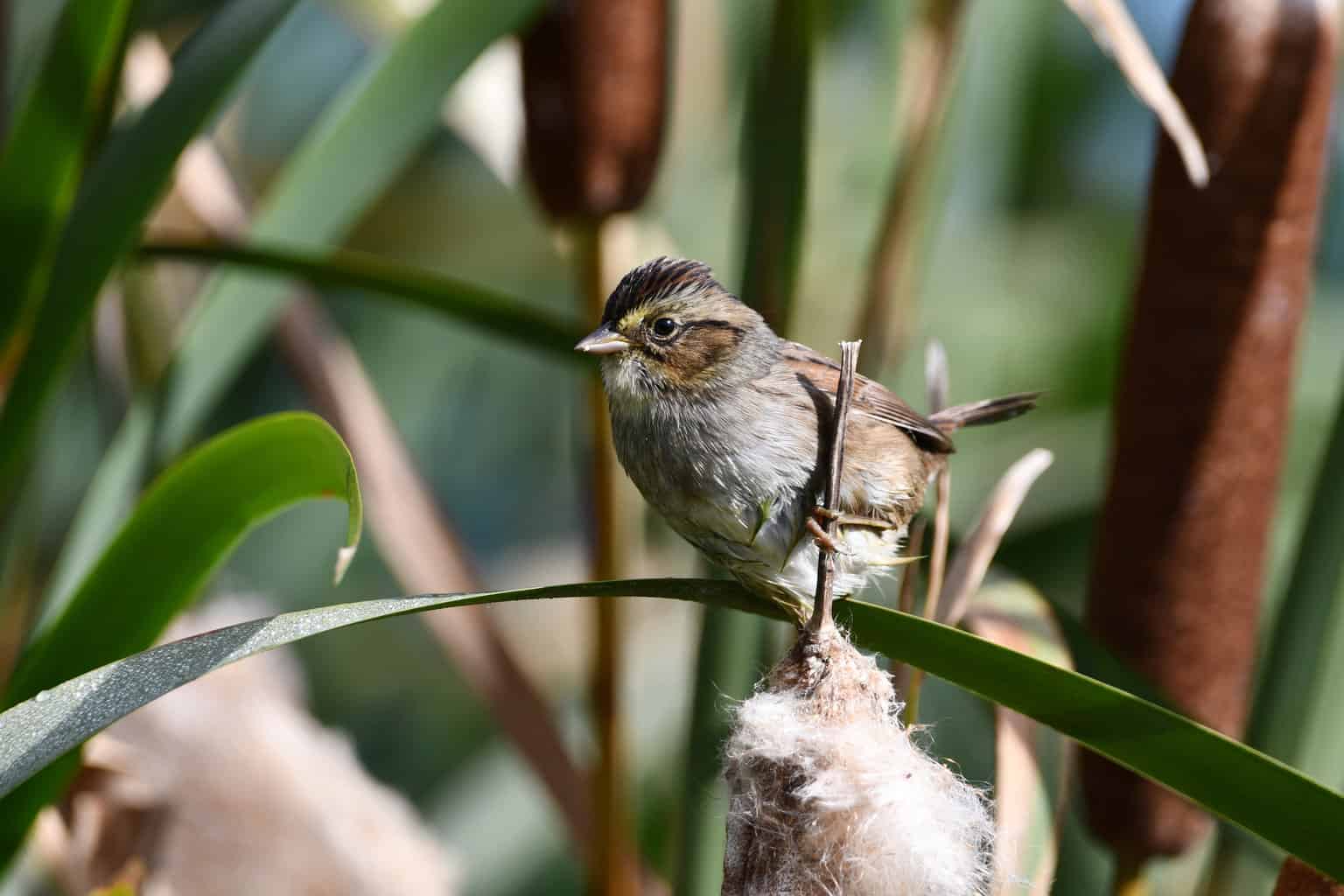
- Scientific Name: Melospiza georgiana
- Length: 4.7-5.9 in (12-15 cm)
- Weight: 0.5-0.8 oz (15-23 g)
- Wingspan: 7.1-7.5 in (18-19 cm)
As their name suggests, swamp sparrows are wetland-loving birds, and that’s where you’ll find them nesting in North Dakota.
Preferring the lower elevations of the eastern half of the state, these little birds prefer to raise their young among damp brush such as willow or alder thickets.
But since the swamp sparrow’s range extends well up into Northern Canada, there are even more of them seen in the spring and fall as they pass through on their regular migration routes.
Song sparrows are notoriously secretive and hard to spot, but a good tip is to listen out for the laugh-like trill that they’ll often start producing long before dawn!
Fox Sparrow

- Species Name: Passerella iliaca
- Length: 5.9-7.5 in (15-19 cm)
- Weight: 0.9-1.6 oz (26-44 g)
- Wingspan: 10.5-11.4 in (26.7-29 cm)
With a light, speckled chest and a wingspan of nearly a foot across, you could be forgiven for confusing a fox sparrow for a small thrush! Their whistling song and way of scratching about in the undergrowth is also rather-thrush-like.
Fox sparrows are another transient species in North Dakota, and the subspecies you’ll see here should always be the red-tinted ‘Taiga’ subspecies. These birds prefer nesting in the arctic circle to the balmy climates of North Dakota, so you’ll only see them here during the spring and fall!
LeConte’s Sparrow
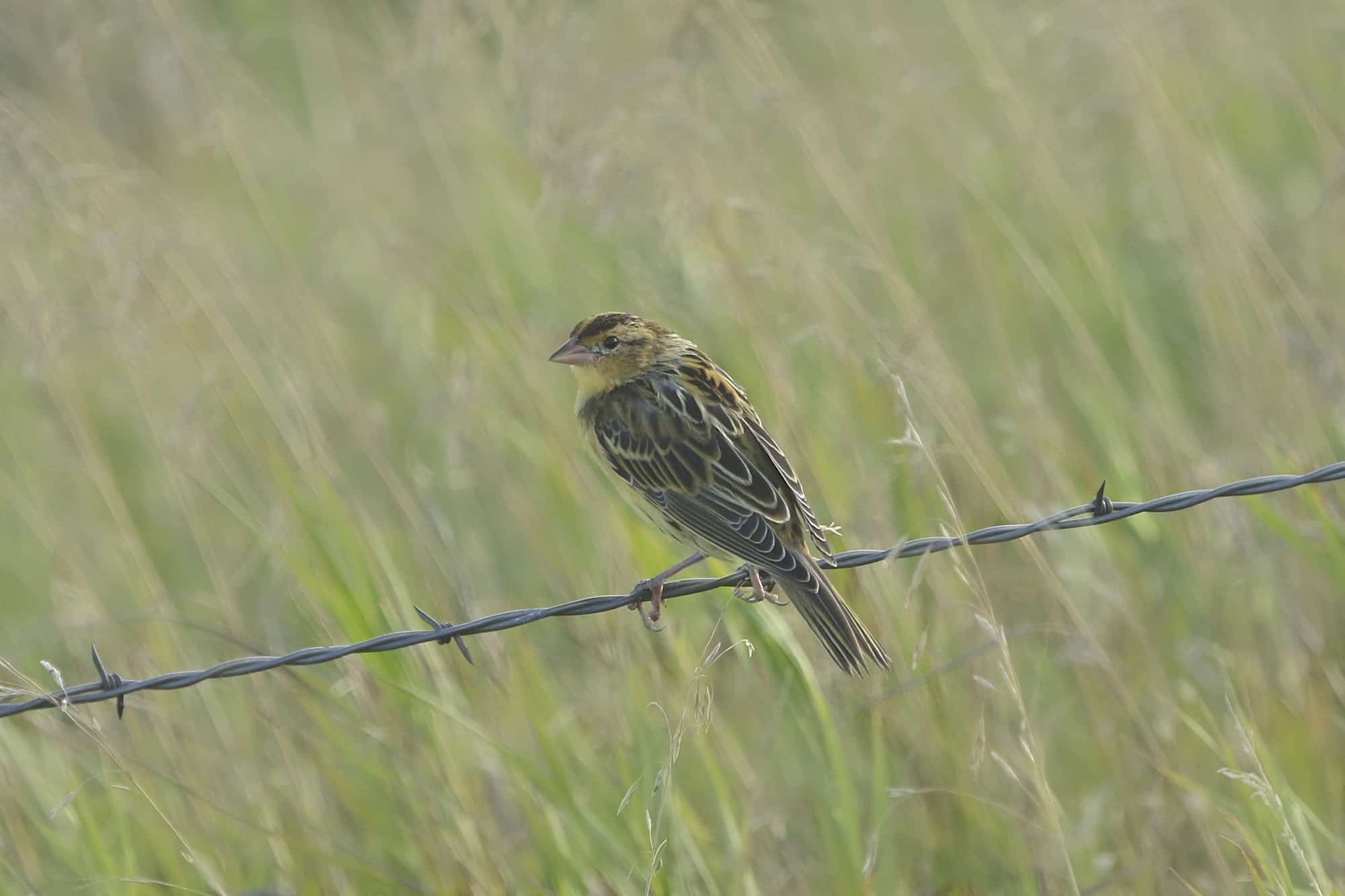
- Species Name: Ammospiza leconteii
- Length: 4.7-5.1 in (12-13 cm)
- Weight: 0.4-0.6 oz (12-16.3 g)
- Wingspan: 6.3-7.1 in (16-18 cm)
A close cousin of the grasshopper sparrow, LeConte’s sparrow is slightly smaller, with a more orange color and a narrower, smaller bill.
They also prefer wetter habitats to grasshopper sparrows and can be found nesting among wet grasslands or sedge marshes in northern and eastern North Dakota.
Like the other grassland birds in their genus, their survival relies on the preservation of their native habitats.
Nelson’s Sparrow
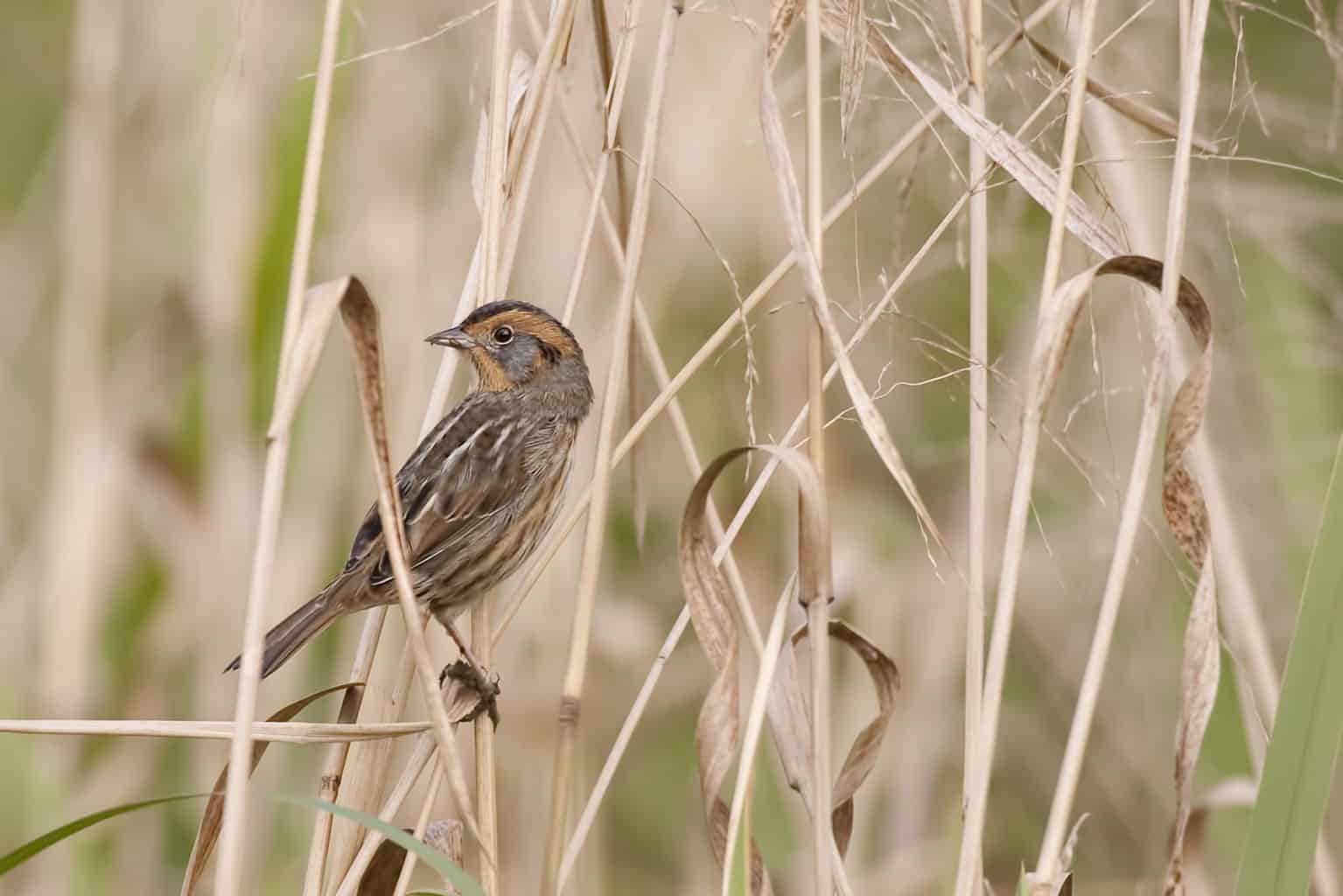
- Scientific Name: Ammospiza nelsoni
- Length: 4.3-5.1 in (11-13 cm)
- Weight: 0.6-0.7 oz (17-21 g)
- Wingspan: 6.5-7.9 in (16.5-20 cm)
Nelson’s sparrow is one of the most recently classified of all sparrow species. That’s because until 1989 they were thought to be the same species as the saltmarsh sparrow! Unlike their purely coastal cousins, however, Nelson’s sparrow sometimes migrates inland to nest in freshwater wetlands, too.
Each spring, small populations of these tiny birds make the long journey from the southeastern coasts to North Dakota and surrounding states to take advantage of the grassy, freshwater marshes.
Although they look a little like LeConte’s sparrow, they are larger, with a longer bill, and nest in even damper habitats than their cousin.
Baird’s Sparrow
- Scientific Name: Centronyx bairdii
- Length: 4.7-5.5 in (12-14 cm)
- Weight: 0.5-0.8 oz (15-21.5 g)
- Wingspan: 8.7-9.1 in (22-23 cm)
Baird’s sparrows are rare, highly localized sparrows that only regularly breed in 3 US states: Montana, South Dakota, and North Dakota.
These stocky little birds are close relatives of the grasshopper sparrow but can be told apart by the sparse, dark streaks on their breasts which are absent in their cousins.
Like other members of their kin, they enjoy nesting in large expanses of dense grassland, so the preservation of native prairies is imperative to their survival.
Rapid conversion of wild grasslands to arable fields has been disastrous for Baird’s sparrow. Because their populations have plummeted by 65% since 1968, this species has been placed on the PIF Yellow Watch List.
Very Rare Sparrows in North Dakota
According to bird watcher’s checklists, all of the above species have been spotted by at least 1 in 100 bird watchers in North Dakota. But there are a few rarer sparrow species still!
Eastern Towhee

- Scientific Name: Pipilo erythrophthalmus
- Length: 6.8-8.2 in (17.3-20.8 cm)
- Weight: 1.1-1.8 oz (32-52 g)
- Wingspan: 7.9-11.0 in (20-28 cm)
Eastern towhees are very close cousins of Spotted towhees, and apart from some minor differences in their morphology, the two species are separated mainly by their range.
Whereas eastern towhees predictably inhabit the eastern states, spotted towhees are typically only found in the western half of America, and their ranges rarely overlap, even in a central state like North Dakota.
Whereas Spotted towhees are regular breeders in the western half of the state, eastern towhees only occasionally stray into the northeastern corner – meaning interbreeding is very rare.
On the rare occasions where Spotted and Eastern towhees do interbreed, they produce hybrid offspring that have the white spots of the spotted towhee, and the distinct white patch of the eastern towhee.
Brewer’s Sparrow
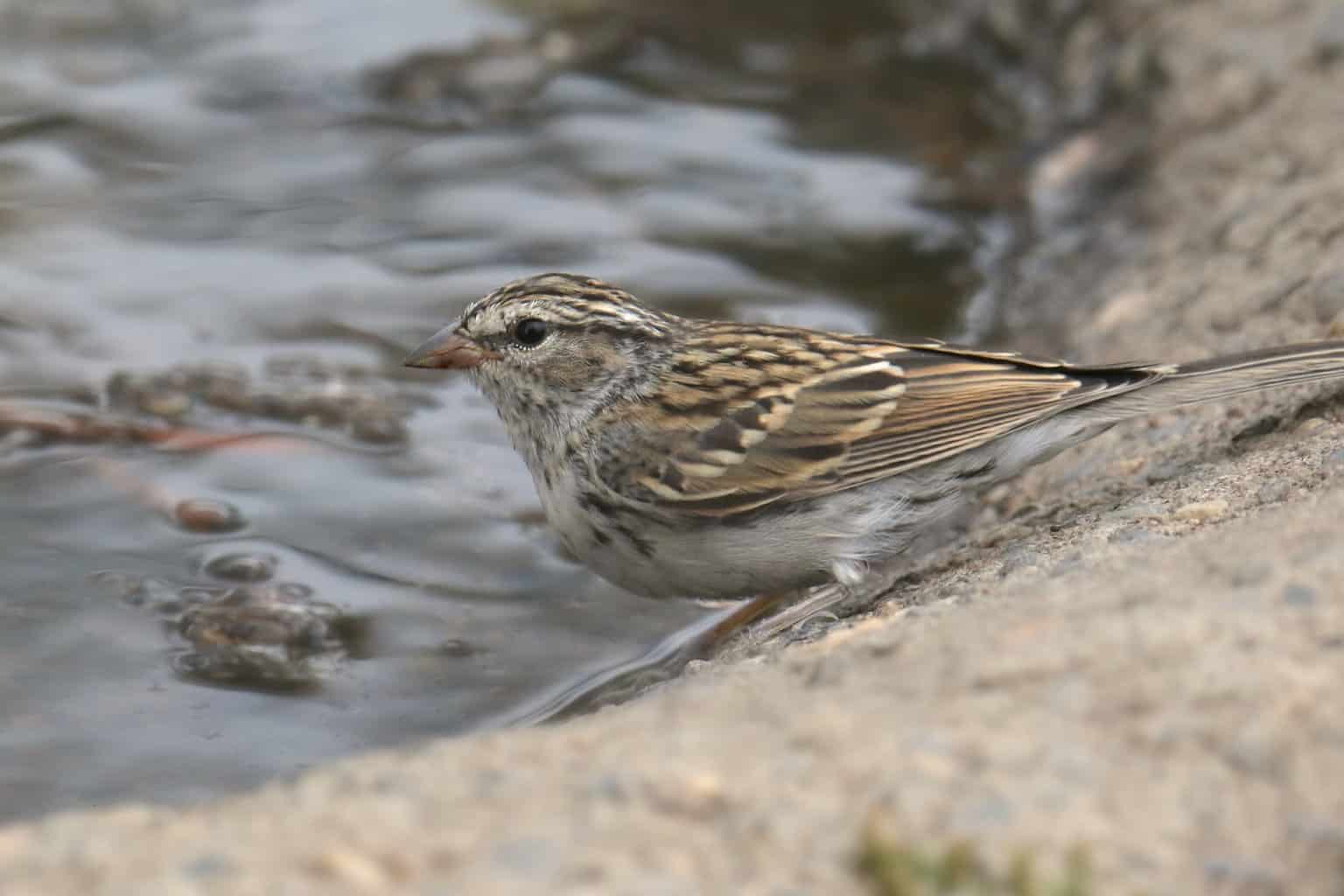
- Scientific Name: Spizella breweri
- Length: 5.1-5.9 in (13-15 cm)
- Weight: 0.3-0.5 oz (11-14 g)
- Wingspan: 7.1-7.9 in (18-20 cm)
Brewer’s sparrows are often quoted as being the smallest sparrow in North America. With an average weight of just 0.37oz, the smallest specimens may weigh less than two teaspoons of sugar!
Apart from their tiny size, this grayish sparrow’s field marks are few. Since its subtle white eye ring and notched tail are two of its only defining features, you might also do well to familiarize yourself with its distinctive, musical song.
The extreme southwestern corner of North Dakota is the only place you’ll find Brewer’s sparrow in the state. They come here purely for nesting, for which they seek out flat, dry expanses with sparse vegetation.
Henslow’s Sparrow
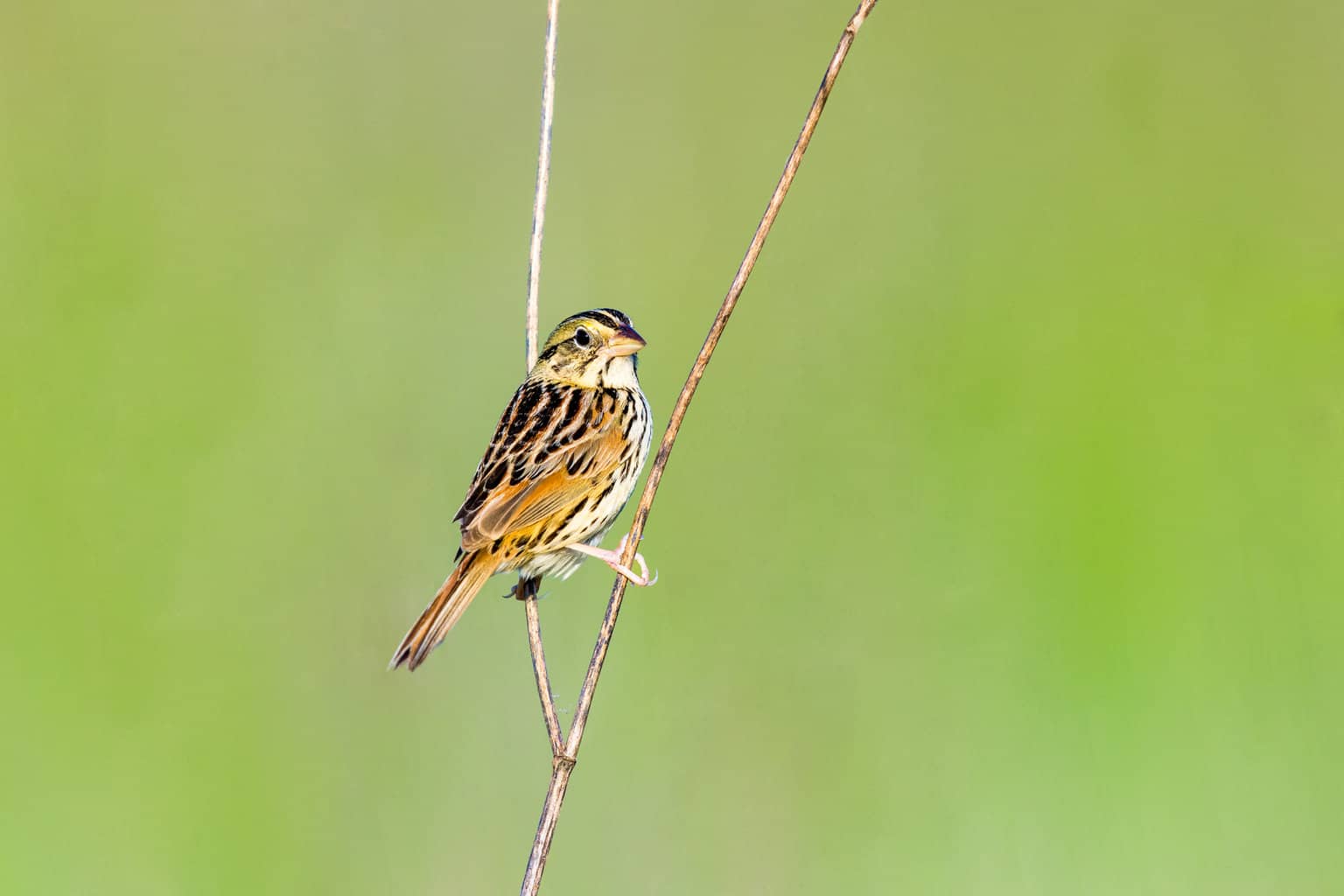
- Scientific Name: Centronyx henslowii
- Length: 4.75 – 5.25 in (12 – 13 cm)
- Weight: 0.5 oz – (14 g)
- Wingspan: 6-7 in – (15 – 18 cm)
Henslow’s sparrows are fairly rare, localized sparrows in the grasshopper sparrow family. They tend to breed in more northeasterly states, but can occasionally be found nesting in the east of North Dakota, too.
Like their close cousin LeConte’s sparrow, these are tiny grassland birds that are solitary and secretive. They prefer to breed in tall-grass prairies and damp weedy meadows.
Sadly, Henslow’s sparrow numbers have been declining, but thankfully schemes such as the Conservation Reserve Program implemented by the United States Department of Agriculture have been helping to stabilize their numbers.
Conclusion
There’s an abundance of sparrow species in North Dakota, although several species are now far less common than they were a few decades ago.
Intensive agriculture and the conversion of wild prairie land into arable fields have had a big impact on the populations of many sparrows. This critical situation means that the preservation and reestablishment of native grasslands will be key for sparrows to flourish for generations to come.
Apart from sparrows, there are more than 300 other species of bird you can find in North Dakota. So whether you’re a lifelong resident, or just passing through on an excursion, be sure to check out our guide to 24 of the most beautiful and iconic birds of the Peace Garden State.

